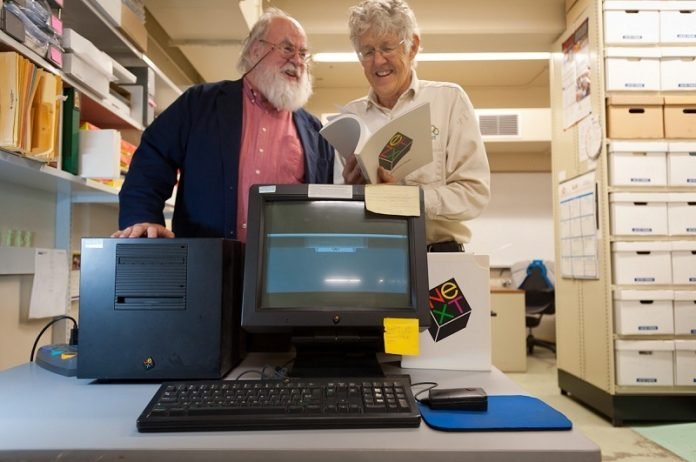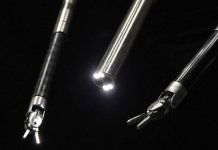
December in 2021 marks the 30-year anniversary of the first website in North America, launched at SLAC.
As the World Wide Web was poised to begin its transformation of modern communications—and, well, life as we know it—a group of staff at the Department of Energy’s SLAC National Accelerator Lab at Stanford University saw an opportunity to vastly improve the exchange of information within large, international physics collaborations.
What was the motivation behind the first website at SLAC?
At the time, I was working with some colleagues to set up what we were calling the “FreeHEP software library.”
The idea was to collect information about software in high energy physics and publicize it, so people would be able to reuse the work of others without starting from scratch.
We had begun to set it up, but we weren’t sure how to make it easily and publically accessible.
Tim Berners-Lee gave one of his first talks about the World Wide Web at a conference in the South of France at the end of 1991.
I was there along with Paul Kunz from SLAC. I remember being really excited to hear about the web! That was exactly what we needed to set up our software library interface, but it could also really help with communication within the high energy physics community.
I was part of the SLAC Large Detector (SLD) collaboration back then, which was very geographically distributed.
We’d write paper documentation, print it and send it in the mail. The web seemed like a perfect way to distribute information to the physics community around the world.
When I returned to SLAC, I went to talk to SLAC librarian Louise Addis. Paul Kunz had already started working with Louise on setting up a web server, SLACVM, on an IBM mainframe for the Stanford Public Information Retrieval System (SPIRES) database.
How was the group dubbed the WWW Wizards?
Louise came up with the name and started the meetings.
Over the next couple of years, we improved SPIRES and set up the FreeHEP web interface, which I believe was not only one of the first applications on the web but also one of the first applications where web pages were created on the fly from a database, rather than static html.
Can you set the stage for us – what was the state of computing at the time?
At SLAC we had a bunch of Ambassador computer terminals connected by wire to the mainframe, and that’s where the scientists would work.
We would create documents on the computer but distribute them on paper via U.S. mail. We put our scientific data on magnetic tapes and sent those (also via mail) to remote sites that wanted to analyze it.
The internet existed long before the web. But the tools available to use the internet, things like File Transfer Protocol (FTP) and text based e-mail and mailing lists, were aimed at non-graphical terminal users, and it was difficult to locate information if you did not already know where it existed.
The web exploited new user interface capabilities available on workstations and personal computers by adding descriptive text and graphics, plus hyperlinks, which made navigating the available information dramatically easier.
Once early web search engines became available, that added yet another way to quickly locate information of interest. The existing tools did not provide a good way to share up-to-date information about our experiments, while the web offered an intuitive, collaborative tool to develop, share and rapidly update such information – which is why we saw it as such a game changer.
What was your role in the development of early SLAC websites?
In addition to helping set up the first web server, I also looked at the web browsers available back then, and I didn’t particularly like any of them.
So, I created my own web browser, which was called MidasWWW. It was unique in that you could search for publications in the SPIRES database but also view the documents online by extracting them from the archives.
In addition to setting up the FreeHEP software catalog and the SPIRES interface, I also set up an SLD collaboration web server.
Around 1992 there was something called The Whole Internet Catalog. It was a manually created document with pointers to all the things that were available on the internet, and it was open sourced.
I put the entire thing on the SLD webserver and publicized it on the WWWtalk mailing list that had been set up. I remember watching during the year how many people were accessing that document, and it was growing exponentially.
Looking back, did any of you have any idea what the Internet would look like now, 30 years later?
I would say yes and no. The “no” part is that had I known, I would have rushed out in 1992 and bought shop.com and buy.com and whatever-else.com, and I’d be a billionaire by now. [laughs]
But we did see, early on, exponential growth in the number of hits our web server was getting and people all over the world setting up web servers.
So, we had some feeling that it was going to be big. I remember writing an article called “Spinning the World Wide Web” for SLAC’s Beam Line magazine in 1994, implying that this could really explode, but I don’t think anyone had any idea just how much.
I remember driving with friends to Tahoe one year to go skiing. An ad came on the radio for a restaurant in Tahoe. I heard them say, “Find out more information by going to http:/name of restaurant,” and I remember thinking, “Wow, this web stuff is really beginning to catch on if you can hear people talking about it on the radio.”
But we certainly didn’t see people having mobile phones in their pockets and the web taking over the entire world the way it has. Initially we just saw it as being something useful in science and academia.
How has the web changed the way physicists and other scientists work today?
I’ve been thinking about how a lot of us have been working from home during COVID, and many of us have been able to work very efficiently from home. In some ways it’s more efficient than going into the lab every day.
Yes, I get to bump into people in the hallways, but we typically work in collaboration with people all over the world.
And given that all our documentation is on the web, all our development is done and distributed on the internet, we have video meetings and use Slack to communicate, the web has really revolutionized the way we work.
I was involved with the Fermi Gamma-ray Space Telescope and now work on the Rubin Observatory. Both of those experiments use the internet to enable us to remotely operate instruments and monitor the data. We can distribute the load to collaborators who are spread out – no one player needs to carry it.
Any predictions about what the future holds?
Well, it’s also true that the web has not exactly developed in the way we would have foreseen or even liked.
We obviously have large companies monopolizing things with private protocols instead of open protocols that everyone can use.
To some extent there is now a push back. I’ve been reading recently about things like Web 3.0, which is an attempt to use things like blockchain and cryptocurrency tools to develop applications that belong to the open-source community, which will make the internet more democratically controlled.
I don’t know if that will happen – it’s hard to overcome the advantages large companies have. But I see people wanting to move in that direction.
Any other outstanding memories from the early days?
When I was working on the Midas web browser, I was contacted by somebody called Marc Andreessen, who was a student at NCSA (National Center for Supercomputing Applications) in Illinois.
He told me he was interested in working with me on the web browser, so I said, “That would be great.” Half a day later he sent me back a message that said, “I’ve looked at all the code, and I like it, but I want to change this, and this, and this and this.” And I remember writing back, “Yeah, I’m busy at the moment.
I don’t think I have time to make all those changes, but I’ll think about it.” So, he went off and invented his own web browser, Mosaic, and later became the co-founder of Netscape and an extremely well-known venture capitalist. Maybe that wasn’t the smartest email I ever sent.
Written by Angela Anderson.



